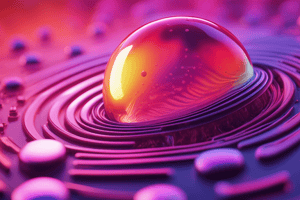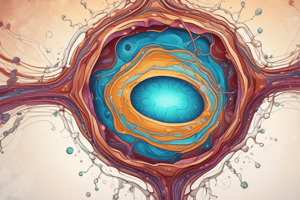Podcast
Questions and Answers
What type of solution has a GREATER concentration of solute molecules OUTSIDE the cell?
What type of solution has a GREATER concentration of solute molecules OUTSIDE the cell?
- Hypertonic Solution (correct)
- Hypotonic Solution
- Isotonic Solution
- None of the above
What type of solution has a GREATER concentration of solute molecules INSIDE the cell?
What type of solution has a GREATER concentration of solute molecules INSIDE the cell?
- Hypertonic Solution
- Hypotonic Solution (correct)
- Isotonic Solution
- None of the above
What happens to animal cells in a hypotonic solution?
What happens to animal cells in a hypotonic solution?
Swelling and bursting
What organelle do plants have that prevents cells from bursting in a hypotonic solution?
What organelle do plants have that prevents cells from bursting in a hypotonic solution?
What type of cell bursts when in a hypotonic solution?
What type of cell bursts when in a hypotonic solution?
What happens to plant cells when placed in a hypertonic solution?
What happens to plant cells when placed in a hypertonic solution?
What maintains the same size of cells in an isotonic solution?
What maintains the same size of cells in an isotonic solution?
The substance that dissolves to make a solution is called what?
The substance that dissolves to make a solution is called what?
During diffusion, molecules tend to move in which direction?
During diffusion, molecules tend to move in which direction?
When the concentration of solute inside and outside a cell is the same, the cell has reached what?
When the concentration of solute inside and outside a cell is the same, the cell has reached what?
The diffusion of water across a selectively permeable membrane is called what?
The diffusion of water across a selectively permeable membrane is called what?
Energy for active transport comes from which part of the cell?
Energy for active transport comes from which part of the cell?
What type of transport requires energy from ATP?
What type of transport requires energy from ATP?
All of the following are kinds of passive transport EXCEPT:
All of the following are kinds of passive transport EXCEPT:
When molecules move DOWN the concentration gradient, they move from where to where?
When molecules move DOWN the concentration gradient, they move from where to where?
Active transport requires what?
Active transport requires what?
What molecule provides the energy for active transport?
What molecule provides the energy for active transport?
What moves oxygen and carbon dioxide molecules across membranes?
What moves oxygen and carbon dioxide molecules across membranes?
Which cell organelles burn glucose to provide ATP for active transport?
Which cell organelles burn glucose to provide ATP for active transport?
Water moves across membranes by which process?
Water moves across membranes by which process?
What is a small membrane sac used to transport substances during exocytosis and endocytosis?
What is a small membrane sac used to transport substances during exocytosis and endocytosis?
What type of transport does NOT require energy?
What type of transport does NOT require energy?
What happens to a cell placed in an isotonic solution?
What happens to a cell placed in an isotonic solution?
What is a solution in which there is a HIGHER concentration of molecules OUTSIDE the cell than inside?
What is a solution in which there is a HIGHER concentration of molecules OUTSIDE the cell than inside?
What forms whenever there is a difference in concentration between one place and another?
What forms whenever there is a difference in concentration between one place and another?
What is a solution in which the concentration of molecules outside the cell is LOWER than inside?
What is a solution in which the concentration of molecules outside the cell is LOWER than inside?
When molecules move from high to low along a concentration gradient, this is called?
When molecules move from high to low along a concentration gradient, this is called?
What type of pressure is caused by water inside a plant cell pushing against the cell wall?
What type of pressure is caused by water inside a plant cell pushing against the cell wall?
In what kind of solution does a plant cell require to not wilt?
In what kind of solution does a plant cell require to not wilt?
In what kind of solution do animal cells require to remain stable?
In what kind of solution do animal cells require to remain stable?
What happens to a red blood cell in a hypotonic solution?
What happens to a red blood cell in a hypotonic solution?
What happens to plant cells in a hypertonic solution?
What happens to plant cells in a hypertonic solution?
What type of solution has a higher solute concentration and less water?
What type of solution has a higher solute concentration and less water?
What type of solution has a high water concentration?
What type of solution has a high water concentration?
What is the transport protein that provides a tubelike opening in the plasma membrane for particles to diffuse?
What is the transport protein that provides a tubelike opening in the plasma membrane for particles to diffuse?
What is used during active transport but not in passive transport?
What is used during active transport but not in passive transport?
What process involves a cell taking in material by forming a vacuole around it?
What process involves a cell taking in material by forming a vacuole around it?
What describes particle movement from an area of higher concentration to an area of lower concentration?
What describes particle movement from an area of higher concentration to an area of lower concentration?
What process involves a cell expelling wastes from a vacuole?
What process involves a cell expelling wastes from a vacuole?
What type of passive transport uses transport proteins?
What type of passive transport uses transport proteins?
What describes particle movement from an area of lower concentration to an area of higher concentration?
What describes particle movement from an area of lower concentration to an area of higher concentration?
What transport protein changes shape when a particle binds with it?
What transport protein changes shape when a particle binds with it?
What factors affect the rate of diffusion?
What factors affect the rate of diffusion?
Flashcards are hidden until you start studying
Study Notes
Cellular Transport Overview
- Hypertonic Solution: Higher concentration of solute outside the cell, causing potential cell shrinkage.
- Hypotonic Solution: Higher concentration of solute inside the cell, leading to cell swelling and possible bursting.
- Isotonic Solution: Equal concentration of solute inside and outside the cell, maintaining cell size.
Cell Responses to Solutions
- Animal Cells in Hypotonic Solutions: Swell and may burst due to excess water intake (cytolysis).
- Plant Cells in Hypotonic Solutions: Swell against the cell wall, prevented from bursting by the cell wall.
- Animal Cells in Hypertonic Solutions: Shrink as water exits the cell.
- Plant Cells in Hypertonic Solutions: Cell membrane pulls away from the cell wall, a phenomenon called plasmolysis.
Key Transport Concepts
- Osmosis: Diffusion of water through a selectively permeable membrane.
- Dynamic Equilibrium: Achieved when the concentration of solute is equal inside and outside the cell.
- Concentration Gradient: Difference in concentration between two regions, driving diffusion.
- Active Transport: Requires energy (ATP) to move substances against their concentration gradient.
- Passive Transport: Does not require energy; particles move down their concentration gradient.
Types of Transport
- Facilitated Diffusion: A form of passive transport that utilizes transport proteins for molecules unable to diffuse freely.
- Endocytosis: Process of a cell taking in material by engulfing it in a vacuole.
- Exocytosis: Process where a cell expels waste through a vacuole.
Membrane Proteins and Functions
- Transport Proteins: Provide channels for substances to pass through the plasma membrane.
- Protein Ion Pump: Transport protein that changes shape to move ions across membranes.
Key Terms and Definitions
- Solute: Substance that dissolves to form a solution.
- Osmotic Pressure: Pressure exerted by water inside plant cells against the cell wall.
- Vesicle: Small membrane sac used for transporting materials in and out of cells.
- ATP (Adenosine Triphosphate): Primary energy currency for cellular processes.
Factors Influencing Diffusion Rate
- Temperature: Increased temperature accelerates diffusion as molecules move faster.
- Shape: Different particles may require different transport methods (diffusion, protein channels, or vesicles).
- Concentration: Greater concentration differences increase diffusion rates.
- Charge: Charged particles struggle to diffuse across membranes, while uncharged ones move more freely.
- Solubility: Non-soluble substances typically cannot diffuse effectively in certain solvents.
Studying That Suits You
Use AI to generate personalized quizzes and flashcards to suit your learning preferences.




